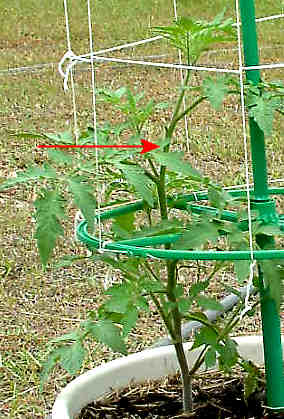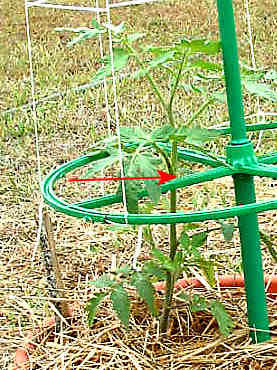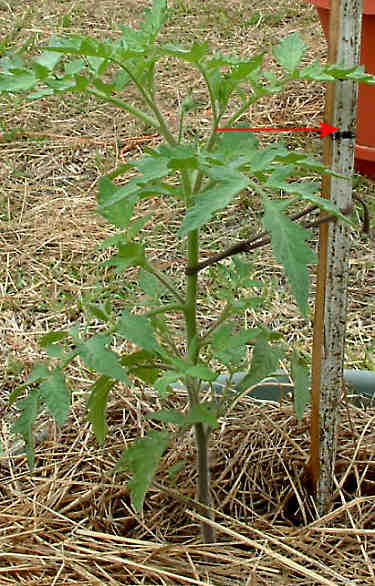GT Experiment Report 1
The Great Tomato Experiment is underway! This is the first report of the series, and the race is just beginning.
While you can read the full story behind The Great Tomato Experiment, a summary is as follows:
There are three plants, grown from seed from the same packet (plant variety is the heirloom tomato Pineapple).
- One plant is the control plant; it gets treated the same was as my other (non-experiment) tomatoes.
- Another plant is being grown for fruit size, per the book Giant Tomatoes.
- The third plant is being grown for productivity of harvest, per the book How to Grow World Record Tomatoes.
All three tomatoes were planted in 10-gallon containers. Because they are planted in containers, they get fed weekly, although about half strength. FYI, the red arrows in the photo indicate how big the plant was when I originally planted it.
(Note: You can click on each of the photos to see a larger version.)
Fruit Size Plant
The first plant is the one I am growing for the size of the fruit. This plant’s soil is about half and half compost and potting mix. Fertilizer has been mainly Miracle Gro for Tomatoes (half strength), as well as some kelp spray and a little bit of fish emulsion. Oh, and I did also add some worm castings.
This plant is by far the largest of the three, as far as height goes. It’s also a little bit leggier, which I suspect is from the Miracle Gro’s higher nutrient count. Because it’s in a container, the plant gets a little Miracle Gro liquid every week, at half strength. It also gets some kelp liquid once a week.
The first blossom buds appeared on this plant, just this past week. But per the book, I pinched them off — the plant needs to grow some more before setting the first fruits. (Oh boy, was it ever hard to pinch those blossoms off!)
Harvest Size Plant
This plant has been lagging behind, but now it’s starting to catch up some. The mix in the container was 100% compost. I also added worm castings, bone meal and blood meal. The plant gets fish emulsion spray once a week, and now that it’s large enough, also a drink of some (slightly diluted) fish emulsion weekly. It also got some kelp meal, and a once-a-week spray of kelp liquid (“Sea Magic”).
This plant is the stockiest of the three plants, even though it’s shortest in height. The theory behing this is that while plants grown 100% organically take longer to “take off” as far as height, they grow better and healthier once they do start to catch up.
And you know what was interesting? When I walked out to the garden at lunch, this plant was noticeably larger/taller than in the photo (taken yesterday morning). The top leaves now drape over the green bar!
Control Plant
The control plant is growing along nicely so far. It’s planting mix was about 70% compost and 30% potting soil.
As far as fertilizer, it’s been mostly organic — worm castings, fish emulsion, kelp meal and spray. I have also added some Tomatoes Alive! all-natural fertilizer. I also gave the plant a shot of Miracle Gro for Tomatoes (diluted to half-strength) about a week after I planted it . The reason I did this is because I saw the underside of the leaves had some purple veining — a good hint that the plant didn’t have enough phosphorus. It’s doing fine now, though, without any extra Miracle Gro.
As far as height and stockiness goes, it’s somewhere between the fruit size and fruit production plants on both counts. So likely I’ll quit using the Miracle Gro, and concentrate on organic methods from this point out with this plant.
When’s the Next Report?
I figure about every two weeks is a good time period between reports. So look for my next one on The Great Tomato Experiment around the end of March. Can’t wait to compare photos then!



Leave a Reply